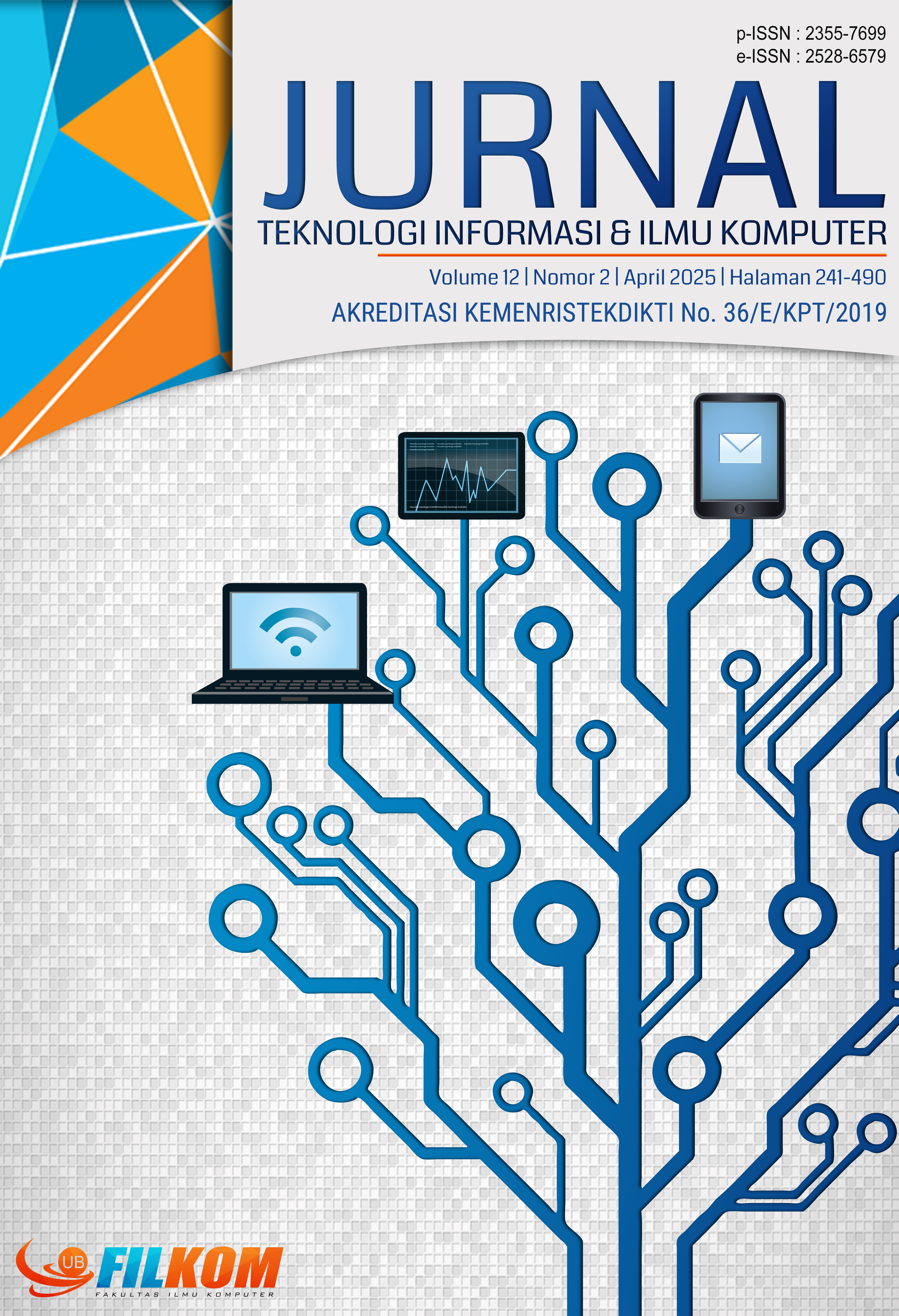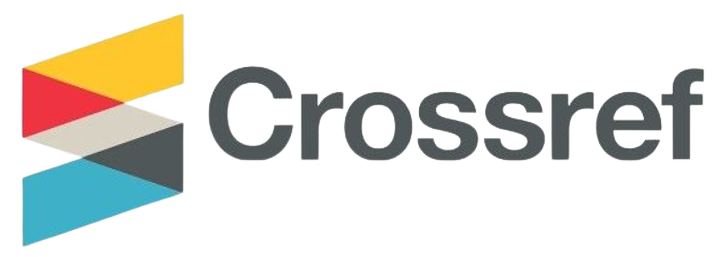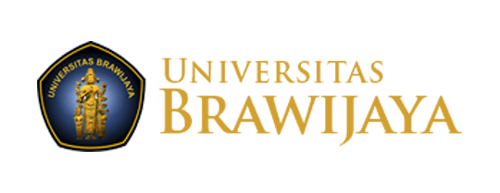Implementasi Convolutional Neural Network untuk Klasifikasi Kanker Usus Besar Dengan Normalisasi Ghostweight
DOI:
https://doi.org/10.25126/jtiik.2025129432Kata Kunci:
CNN, Classification, Colon Cancer, Ghost Weight NormalizationAbstrak
Kanker usus besar merupakan salah satu kanker yang dapat menyebabkan kematian. Jenis kanker ini merupakan kanker peringkat kedua terbanyak pada wanita dan peringkat ketiga terbanyak pada pria. Akhir–akhir ini, pendekatan Deep Learning (DL) banyak digunakan untuk melakukan proses–proses dalam dunia medis. Salah satu metode yang terkenal yaitu Convolutional Neural Network (CNN). CNN tentunya harus memiliki akurasi yang tinggi untuk dapat diterapkan pada kasus ini. Dataset yang digunakan adalah dataset Lung and Colon Cancer Histopathological Images yang berfokus pada kanker ususnya saja. Salah satu cara yang dapat digunakan untuk meningkatkan akurasi pada CNN adalah dengan menormalisasi bobot. Untuk ini, metode yang diusulkan adalah Ghost Weight Normalization (GWN) dengan normalisasi L1 yang terinspirasi dari GhostNet. Metode ini bekerja dengan cara melakukan pembagian bobot utuh menjadi beberapa bagian yang dinamakan GW dan kemudian dinormalisasi untuk setiap GW-nya, lalu digabung kembali menjadi bobot utuh seperti semula. Pendekatan ini terbukti dapat meningkatkan akurasi CNN dengan sangat baik, yaitu mengalami penambahan akurasi sebesar 14% yang semula CNN biasa memperoleh akurasi sebesar 0.8 menjadi 0.94, presisi 0.8 menjadi 0.94 dan F1-score 0.8 menjadi 0.94. GWN juga dapat mengungguli gaya normalisasi biasa, yaitu normalisasi pada bobot tanpa membaginya menjadi GW. Ukuran GW yang efisien adalah 4 dengan perolehan akurasi, persisi, dan f1-score masing-masing 0.94, dengan epoch 8 dan rata – rata untuk waktu proses training-nya pada setiap epoch-nya adalah 259 detik.
Abstract
Colon cancer is one of the cancers that can cause death. This type of cancer is the second most common cancer in women and the third most common in men. Lately, Deep Learning (DL) approaches have been widely used to perform processes in the medical world. One of the well-known methods is Convolutional Neural Network (CNN). The method should have high accuracy to be applied in this case. The dataset used is the Lung and Colon Cancer Histopathological Images dataset which focuses on Colon Cancer only. One way that can be used to improve accuracy on CNN is by normalizing the weights. Our proposed method is Ghost Weight Normalization (GWN) with L1 normalization inspired by GhostNet. This method works by dividing the whole weight into several parts called GW and then normalized for each GW, then merged back into the whole weight as before. This approach proved to be able to improve the accuracy of CNN very well, which experienced an increase in accuracy by 14% from the usual CNN accuracy of 0.8 to 0.94, precision 0.8 to 0.94, and f1-score 0.8 to 0.94. GWN can also outperform the usual normalization style, which is normalizing the weights without dividing them into GWs. The efficient GW size is 4 with accuracy, precision, and f1-score of 0.94 each, with 8 epochs and the average training time for each epoch is 259 seconds.
Downloads
Referensi
ELNGAR, A. A., ARAFA, M., FATHY, A., MOUSTAFA, B., MAHMOUD, O., SHABAN, M., & FAWZY, N. 2021. Image Classification Based On CNN: A Survey. Journal of Cybersecurity and Information Management (JCIM), 6(1), 18. https://doi.org/10.5281/zenodo.4897990
FARID NAUFAL, M., & FERDIANA KUSUMA, S. 2021. Pendeteksi Citra Masker Wajah Menggunakan CNN Dan Transfer Learning. Jurnal Teknologi Informasi Dan Ilmu Komputer (JTIIK), 8(6), 1293–1300. https://doi.org/10.25126/jtiik.202185201
HAN, K., WANG, Y., TIAN, Q., GUO, J., XU, C., & XU, C. 2020. GhostNet: More Features from Cheap Operations. CVPR, 1580–1589.
ISWANTORO, D., & Handayai UN, D. 2022. Klasifikasi Penyakit Tanaman Jagung Menggunakan Metode Convolutional Neural Network (CNN). Jurnal Ilmiah Universitas Batanghari Jambi, 22(2), 900. https://doi.org/10.33087/jiubj.v22i2.2065
LI, C., & SUN, L. 2021. Multi-label Anomaly Classification Based on Electrocardiogram. In H. and C. L. and G. Y. and X. C. Siuly Siuly and Wang (Ed.), Health Information Science (pp. 171–178). Springer International Publishing.
LUBIS, C., & YULIARTO, D. 2023. Klasifikasi Penyakit Kulit Menggunakan Convolutional Neural Network (CNN) Dengan Arsitektur VGG16. JURNAL SISTEM INFORMASI DAN TEKNIK KOMPUTER, 8(1).
MISHRA, S., & SANODIYA, R. K. 2022. Scatter Matrix Normalization for Unsupervised Domain Adaptation. 9th IEEE Uttar Pradesh Section International Conference on Electrical, Electronics and Computer Engineering, UPCON 2022.
https://doi.org/10.1109/UPCON56432.2022.9986396
NAUFAL, M. F. 2021. Analisis Perbandingan Algoritma SVM, KNN, Dan CNN Untuk Klasifikasi Citra Cuaca. Jurnal Teknologi Informasi Dan Ilmu Komputer (JTIIK), 8(2), 311–318. https://doi.org/10.25126/jtiik.202184553
NUGROHO, B., & YULIA, E. 2021. Kinerja Metode CNN Untuk Klasifikasi Pneumonia Dengan Variasi Ukuran Citra Input. Jurnal Teknologi Informasi Dan Ilmu Komputer (JTIIK), 8(3), 533–538. https://doi.org/10.25126/jtiik.202184515
ROY, S., PANDA, P., SRINIVASAN, G., & RAGHUNATHAN, A. 2020. Pruning Filters while Training for Efficiently Optimizing Deep Learning Networks. 2020 International Joint Conference on Neural Networks (IJCNN).
SARWINDA, D., PARADISA, R. H., BUSTAMAM, A., & ANGGIA, P. 2021. Deep Learning in Image Classification using Residual Network (ResNet) Variants for Detection of Colorectal Cancer. Procedia Computer Science, 179, 423–431. https://doi.org/10.1016/j.procs.2021.01.025
SETIYONO, B., RIV’AN ARIF, M., AINI, Q. Q., SOEGIANTO, T. H., OHANNA, J., ANDREAN, R., GUNAWAN, F., & RIZKIA, A. P. 2023. Identifikasi Tanaman Obat Indonesia Melalui Citra Daun Menggunakan Metode Convolutional Neural Network (CNN). Jurnal Teknologi Informasi Dan Ilmu Komputer (JTIIK), 10(2), 385–392. https://doi.org/10.25126/jtiik.2023106809
SUOMINEN, M., SUBASI, M. E., & SUBASI, A. 2024. Chapter 9 - Automated detection of colon cancer from histopathological images using deep neural networks. In A. Subasi (Ed.), Applications of Artificial Intelligence in Healthcare and Biomedicine (pp. 243–287).
Academic Press. https://doi.org/https://doi.org/10.1016/B978-0-443-22308-2.00014-7
WAHID, R. R., NISA’, C., AMALIYAH, R. P., & PUSPANINGRUM, E. Y. 2021. Lung and colon cancer detection with convolutional neural networks on histopathological images. PROCEEDINGS OF THE 7TH INTERNATIONAL CONFERENCE ON SCIENCE AND TECHNOLOGY.
WEN, M., XU, Y., ZHEN, Y., YANG, Z., & WANG, X. 2021. Sparse Deep Neural Networks Using L1 Weight Normalization. Statistica Sinica, 31(3), 1397–1414. https://www.jstor.org/stable/27034823
WU, X., DOBRIBAN, E., REN, T., WU, S., LI, Z., GUNASEKAR, S., WARD, R., & LIU, X. 2020. Implicit Regularization and Convergence for Weight Normalization. In H. Larochelle, M. Ranzato, R. Hadsell, M. F. Balcan, & H. Lin (Eds.), Advances in Neural Information Processing Systems (Vol. 33, pp. 2835–2847). Curran Associates, Inc. https://proceedings.neurips.cc/paper_files/paper/2020/file/1de7d2b90d554be9f0db1c338e80197d-Paper.pdf
YUAN, X., SHEN, X., MEHTA, S., LI, T., GE, S., & ZHA, Z. 2022. Structure injected weight normalization for training deep networks. Multimedia Systems, 28(2), 433–444. https://doi.org/10.1007/s00530-021-00793-7
ZHOU, W., LIU, A., WU, L., & CHEN, X. 2022. A L1 normalization enhanced dynamic window method for SSVEP-based BCIs. Journal of Neuroscience Methods, 380. https://doi.org/10.1016/j.jneumeth.2022.109688
Unduhan
Diterbitkan
Terbitan
Bagian
Lisensi
Hak Cipta (c) 2025 Jurnal Teknologi Informasi dan Ilmu Komputer

Artikel ini berlisensiCreative Commons Attribution-ShareAlike 4.0 International License.

Artikel ini berlisensi Creative Common Attribution-ShareAlike 4.0 International (CC BY-SA 4.0)
Penulis yang menerbitkan di jurnal ini menyetujui ketentuan berikut:
- Penulis menyimpan hak cipta dan memberikan jurnal hak penerbitan pertama naskah secara simultan dengan lisensi di bawah Creative Common Attribution-ShareAlike 4.0 International (CC BY-SA 4.0) yang mengizinkan orang lain untuk berbagi pekerjaan dengan sebuah pernyataan kepenulisan pekerjaan dan penerbitan awal di jurnal ini.
- Penulis bisa memasukkan ke dalam penyusunan kontraktual tambahan terpisah untuk distribusi non ekslusif versi kaya terbitan jurnal (contoh: mempostingnya ke repositori institusional atau menerbitkannya dalam sebuah buku), dengan pengakuan penerbitan awalnya di jurnal ini.
- Penulis diizinkan dan didorong untuk mem-posting karya mereka online (contoh: di repositori institusional atau di website mereka) sebelum dan selama proses penyerahan, karena dapat mengarahkan ke pertukaran produktif, seperti halnya sitiran yang lebih awal dan lebih hebat dari karya yang diterbitkan. (Lihat Efek Akses Terbuka).














